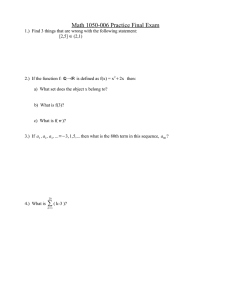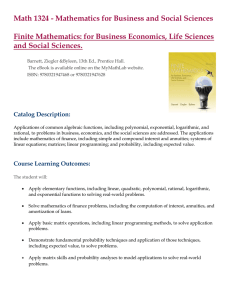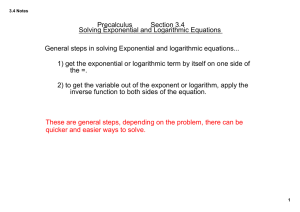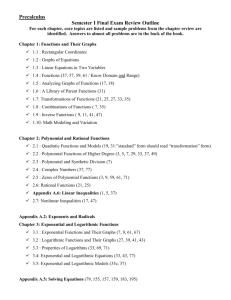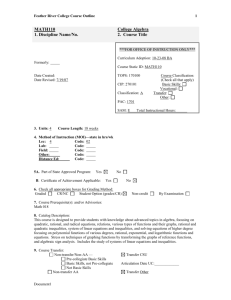CURRICULUM PROPOSAL College of the Redwoods
advertisement
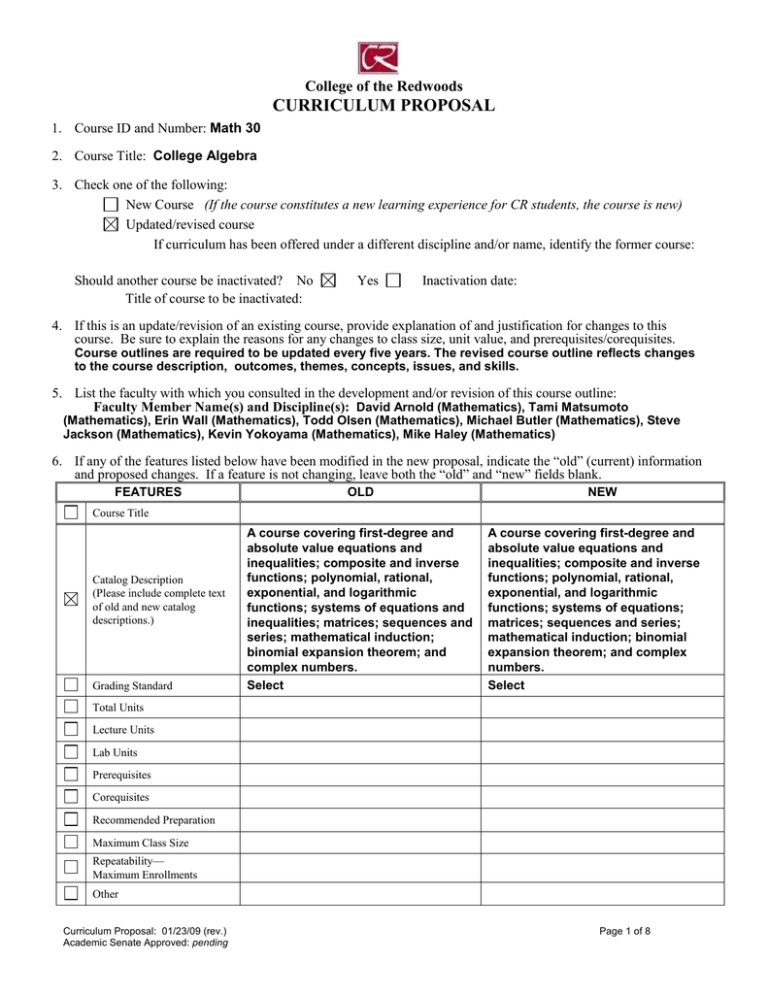
College of the Redwoods CURRICULUM PROPOSAL 1. Course ID and Number: Math 30 2. Course Title: College Algebra 3. Check one of the following: New Course (If the course constitutes a new learning experience for CR students, the course is new) Updated/revised course If curriculum has been offered under a different discipline and/or name, identify the former course: Should another course be inactivated? No Title of course to be inactivated: Yes Inactivation date: 4. If this is an update/revision of an existing course, provide explanation of and justification for changes to this course. Be sure to explain the reasons for any changes to class size, unit value, and prerequisites/corequisites. Course outlines are required to be updated every five years. The revised course outline reflects changes to the course description, outcomes, themes, concepts, issues, and skills. 5. List the faculty with which you consulted in the development and/or revision of this course outline: Faculty Member Name(s) and Discipline(s): David Arnold (Mathematics), Tami Matsumoto (Mathematics), Erin Wall (Mathematics), Todd Olsen (Mathematics), Michael Butler (Mathematics), Steve Jackson (Mathematics), Kevin Yokoyama (Mathematics), Mike Haley (Mathematics) 6. If any of the features listed below have been modified in the new proposal, indicate the “old” (current) information and proposed changes. If a feature is not changing, leave both the “old” and “new” fields blank. FEATURES OLD NEW Course Title Catalog Description (Please include complete text of old and new catalog descriptions.) Grading Standard A course covering first-degree and absolute value equations and inequalities; composite and inverse functions; polynomial, rational, exponential, and logarithmic functions; systems of equations and inequalities; matrices; sequences and series; mathematical induction; binomial expansion theorem; and complex numbers. Select A course covering first-degree and absolute value equations and inequalities; composite and inverse functions; polynomial, rational, exponential, and logarithmic functions; systems of equations; matrices; sequences and series; mathematical induction; binomial expansion theorem; and complex numbers. Select Total Units Lecture Units Lab Units Prerequisites Corequisites Recommended Preparation Maximum Class Size Repeatability— Maximum Enrollments Other Curriculum Proposal: 01/23/09 (rev.) Academic Senate Approved: pending Page 1 of 8 College of the Redwoods COURSE OUTLINE 1. DATE: Dec. 1, 2010 2. DIVISION: Math, Science, and Engineering 3. COURSE ID AND NUMBER: Math 30 4. COURSE TITLE (appears in catalog and schedule of classes): College Algebra 5. SHORT TITLE (appears on student transcripts; limited to 30 characters, including spaces): College Algebra 6. LOCAL ID (TOPS): 1701.00 (Taxonomy of Program codes http://www.cccco.edu/Portals/4/AA/CP%20&%20CA3/TopTax6_rev_07.doc) 7. NATIONAL ID (CIP): 270101 (Classification of Instructional Program codes can be found in Appendix B of the TOPS code book http://www.cccco.edu/Portals/4/AA/CP%20&%20CA3/TopTax6_rev_07.doc) 8. Discipline(s): Select from CCC System Office Minimum Qualifications for Faculty http://www.cccco.edu/SystemOffice/Divisions/AcademicAffairs/MinimumQualifications/MQsforFacultyandAdministrators/tabid/753/Default.aspx Course may fit more than one discipline; identify all that apply: Mathematics 9. FIRST TERM NEW OR REVISED COURSE MAY BE OFFERED: Summer 2011 10. TOTAL UNITS: 4 TOTAL HOURS: 72 [Lecture Units: 4 Lab Units: 0] [Lecture Hours: 72 Lab Hours: 0] (1 unit lecture=18 hours; 1 unit lab=54 hours) 11. MAXIMUM CLASS SIZE: 40 12. WILL THIS COURSE HAVE AN INSTRUCTIONAL MATERIALS FEE? No Yes Fee: $ (If “yes,” attach a completed “Instructional Materials Fee Request Form”—form available in Public Folders>Curriculum>Forms) GRADING STANDARD Letter Grade Only Pass/No Pass Only Is this course a repeatable lab course: No Yes Grade-Pass/No Pass Option If yes, how many total enrollments? Is this course to be offered as part of the Honors Program? No Yes If yes, explain how honors sections of the course are different from standard sections. CATALOG DESCRIPTION -- The catalog description should clearly describe for students the scope of the course, its level, and what kinds of student goals the course is designed to fulfill. The catalog description should begin with a sentence fragment. A course covering first-degree and absolute value equations and inequalities; composite and inverse functions; polynomial, rational, exponential, and logarithmic functions; systems of equations; matrices; sequences and series; mathematical induction; binomial expansion theorem; and complex numbers. Special notes or advisories (e.g. field trips required, prior admission to special program required, etc.): calculator required, TI-83 or 84 recommended. Graphing PREREQUISITE COURSE(S) No Yes Course(s): Math 120 (or equivalent) with a grade of "C" or better or appropriate score on the math placement exam. Rationale for Prerequisite: Describe representative skills without which the student would be highly unlikely to succeed. Ability to solve linear, quadratic, polynomial, rational, radical, exponential, and logarithmic equations analytically, graphically, numerically, and verbally in real-world settings. Ability to use technology in the study of these Curriculum Proposal: 01/23/09 (rev.) Academic Senate Approved: pending Page 2 of 8 functions. COREQUISITE COURSE(S) No Yes Rationale for Corequisite: Course(s): RECOMMENDED PREPARATION No Yes Course(s): Rationale for Recommended Preparation: COURSE LEARNING OUTCOMES –This section answers the question “what will students be able to do as a result of taking this course?” State some of the objectives in terms of specific, measurable student actions (e.g. discuss, identify, describe, analyze, construct, compare, compose, display, report, select, etc.). For a more complete list of outcome verbs please see Public Folders>Curriculum>Help Folder>SLO Language Chart. Each outcome should be numbered. 1. Evaluate and interpret a difference quotient symbolically, numerically, and graphically. 2. Find and interpret the real and complex roots of a polynomial symbolically, numerically, and graphically. 3. Produce an accurate graph of a rational function by hand, and identify all salient features. 4. Demonstrate and interpret the inverse relationship between exponential and logarithmic functions. 5. Solve problems and applications involving exponential and logarithmic functions. 6. Solve 3x3 linear systems of equations using matrices and elimination, and interpret the nature of the solution set geometrically. 7. Recognize and solve problems involving arithmetic and geometric sequences and series. COURSE CONTENT–This section describes what the course is “about”-i.e. what it covers and what knowledge students will acquire Concepts: What terms and ideas will students need to understand and be conversant with as they demonstrate course outcomes? Each concept should be numbered. 1. A multiple-step problem-solving process. 2. The presentation of mathematical solutions in a logical and coherent structure, including the use of writing skills, grammar, and punctuation. 3. The use of the graphing calculator as a problem-solving tool. 4. The connection between graphs and properties of functions. 5. Application of concepts to real-world problems. 6. Knowledge of functions to include definitions, graphs, properties, and their application to the problem-solving process. 7. The recognition that the use of proper algebraic skills is an important tool in problem-solving situations. Issues: What primary tensions or problems inherent in the subject matter of the course will students engage? Each issue should be numbered. 1. The role of the student in becoming a successful learner. 2. The importance of writing mathematics using correct notation and grammar. 3. The limitations of technology. 4. The connection between mathematics, science, and the "real world." 5. The necessity to read unfamiliar mathematics using the textbook and other resources. Themes: What motifs, if any, are threaded throughout the course? Each theme should be numbered. 1. Functions. 2. Critical thinking. 3. Problem solving. 4. Algebraic skills. 5. Use of technology. 6. Graphing and data analysis. 7. Communication. Skills: What abilities must students have in order to demonstrate course outcomes? (E.g. write clearly, use a scientific calculator, read college-level texts, create a field notebook, safely use power tools, etc). Each skill should be numbered. Curriculum Proposal: 01/23/09 (rev.) Academic Senate Approved: pending Page 3 of 8 1. Use a calculator to: graph a function, find an appropriate viewing window, trace, find intersections, zeros, extrema, increasing/decreasing intervals, continuity and inverses; approximate solutions to equations and inequalities; solve systems of equations. Understand the technological limits of the calculator. 2. Be able to identify the properties of linear, quadratic, polynomial, rational, radical, exponential, logarithmic, absolute value functions, piecewise functions, arithmetic sequences, geometric sequences, and series. 3. Analysis of Graphs: • Determine the domain and range of a function. • Identify intervals of the domain for which a function is increasing/decreasing/constant. • Identify zeros and intervals of the domain for which a function is positive/negative. • Identify local and absolute extrema. • Analyze functions and relations for symmetry. • Analytically determine whether a function is even, odd, or neither. • Identify the graph of a function or relation that has been translated by a vertical or horizontal shift. • Identify the graph of a function that has been vertically or horizontally stretched or compressed. • Identify the graph of a function that has been reflected across an axis. • Evaluate and interpret the difference quotient as the slope of a secant line for a given function. 4. Solve equations and inequalities involving linear, quadratic, polynomial, rational, radical, exponential, logarithmic, and absolute value functions. 5. Piecewise and Absolute Value Functions: • Evaluate and graph piecewise functions. • Express functions involving absolute value as piecewise functions, and sketch their graphs. • Solve equations and inequalities involving absolute value functions. • Apply absolute value to real-world situations. 6. Polynomial Functions: • Determine the exact zeros (both real and complex) and their multiplicities of polynomial functions by applying the Rational Zeros Theorem, Factor Theorem, Remainder Theorem, Fundamental Theorem of Algebra, and the Conjugate Zeros Theorem. • Use the end behavior of a polynomial function and the behavior near its zeros to sketch the graph. • Divide polynomials by long division. Divide a polynomial by a linear factor using synthetic division. • Solve polynomial equations and inequalities. 7. Rational Functions: • Identify the domain, range, vertical asymptotes, horizontal asymptotes, oblique asymptotes, discontinuities, and zeros. Determine the end behavior and behavior near zeros and discontinuities. Use this information to sketch the graph. • Solve rational equations and inequalities. • Solve applications of rational functions, including equations involving direct, inverse, and joint variation. 8. Inverse Functions: • Identify one-to-one functions both analytically and using the horizontal line test. • Sketch the graph of a function and its inverse. • Apply composition of functions to prove functions are inverses. • Find the inverse of a function algebraically. • Find the inverse of a function with a restricted domain. 9. Exponential Functions: • Use the laws of exponents to simplify expressions. • Identify the domain, range, intercepts, and asymptotes. Use this information and transformation theory to sketch the graph. • Compare graphs of exponential growth and decay functions, and develop exponential models for real-world applications. 10. Logarithmic Functions: • Use the definition of a logarithm (as the inverse of the exponential) to convert equations between logarithmic and exponential forms. • Identify the domain, range, intercepts, and asymptotes. Use this information and transformation Curriculum Proposal: 01/23/09 (rev.) Academic Senate Approved: pending Page 4 of 8 theory to sketch the graph. Simplify and evaluate logarithmic expressions using the properties of logarithms. Solve exponential and logarithmic equations. Solve problems involving discrete and continuous compound interest. Solve problems involving exponential growth/decay, Newton's law of cooling, logistic growth, and logarithmic scales. 11. Systems of equations: • Solve systems of two linear equations in two unknowns using the elimination method. • Solve systems of three linear equations in three unknowns using the elimination method. • Solve 3x3 linear systems using elementary row operations, row echelon and reduced row echelon forms, and the graphing calculator. • Compute 2x2 determinants and solve 2x2 systems using Cramer's Rule. • Solve linear systems involving investments, mixture, rate, and work. 12. Sequences and Series: • Identify the sequence as a function on the set of natural numbers. • Generate the terms of a sequence defined by a recursive formula. • Apply formulae for the nth term and sum of the first n terms of arithmetic and geometric sequences and series. • Determine whether an infinite geometric series is convergent or divergent. Find the sum of a convergent geometric series. • Apply sequence and series concepts to real-world problems. 13. Write proofs using the Principle of Mathematical Induction. 14. The Binomial Theorem: • Expand a binomial using the binomial theorem. • Find a specific term in the expansion of a binomial. • • • • REPRESENTATIVE LEARNING ACTIVITIES –This section provides examples of things students may do to engage the course content (e.g., listening to lectures, participating in discussions and/or group activities, attending a field trip). These activities should relate directly to the Course Learning Outcomes. Each activity should be numbered. 1. Listening to lectures. 2. Participating in group activities or assignments. 3. Participating in in-class assignments or discussions. 4. Completing daily homework assignments. 5. Completing online activities on the computer. ASSESSMENT TASKS –This section describes assessments instructors may use to allow students opportunities to provide evidence of achieving the Course Learning Outcomes. Each assessment should be numbered. Representative assessment tasks (These are examples of assessments instructors could use): 1. In-class exams. 2. Writing assignments to develop communication of mathematical concepts. 3. Quizzes. 4. Group projects or other in-class activities. 5. Portfolios. 6. Individual projects or presentations. Required assessments for all sections (These are assessments that are required of all instructors of all sections at all campuses/sites. Not all courses will have required assessments. Do not list here assessments that are listed as representative assessments above.): 1. At least two proctored, closed-book examinations, plus a comprehensive final examination. EXAMPLES OF APPROPRIATE TEXTS OR OTHER READINGS –This section lists example texts, not required texts. Author, Title, and Date Fields are required Author Hornsby, Lial, Rockswold Author Sullivan Title Author Title Title A graphical Approach to College Algebra, 5th ed. Algebra and Trigonometry, 8th ed. Date Date 2011 2008 Date Curriculum Proposal: 01/23/09 (rev.) Academic Senate Approved: pending Page 5 of 8 Author Title Date Other Appropriate Readings: COURSE TYPES 1. Is the course part of a Chancellor’s Office approved CR Associate Degree? No Yes If yes, specify all program codes that apply. (Codes can be found in Outlook/Public Folders/All Public Folders/ Curriculum/Degree and Certificate Programs/choose appropriate catalog year): Required course for degree(s) Restricted elective for degree (s) SCI.LA.A.AA, SCI.LA.B.AA, SCI.LA.C.AA, SCI.LA.D.AA, SCIEX.LA.A.AA, SCIEX.LA.B.AA, SCIEX.LA.C.AA, SCIEX.LA.D.AA, MS.AS, MS.CA, FNR.AS.FOR.TECH Restricted electives are courses specifically listed (i.e. by name and number) as optional courses from which students may choose to complete a specific number of units required for an approved degree. 2. Is the course part of a Chancellor’s Office approved CR Certificate of Achievement? No Yes If yes, specify all program codes that apply. ( Codes can be found in Outlook/Public Folders/All Public Folders/ Curriculum/Degree and Certificate Programs/choose appropriate catalog year): Required course for certificate(s) Restricted elective for certificate(s) Auto.CA Restricted electives are courses specifically listed (i.e. by name and number) as optional courses from which students may choose to complete a specific number of units required for an approved certificate. 3. Is the course Stand Alone? No Yes (If “No” is checked for BOTH #1 & #2 above, the course is stand alone) 4. Basic Skills: NBS Not Basic Skills 5. Work Experience: NWE Not Coop Work Experience 6. Course eligible Career Technical Education funding (applies to vocational and tech-prep courses only): yes 7. Purpose: A Liberal Arts Sciences 8. Accounting Method: W Weekly Census 9. Disability Status: N Not a Special Class no CURRENT TRANSFERABILITY STATUS This course is currently transferable to Neither CSU nor UC CSU as general elective credit CSU as a specific course equivalent (see below) If the course transfers as a specific course equivalent, give course number(s)/ title(s) of one or more currently-active, equivalent lower division courses from CSU. 1. Course Math 1130, Campus CSU East Bay 2. Course Math 118, Campus Cal Poly SLO UC as general elective credit UC as specific course equivalent If the course transfers as a specific course equivalent, give course number(s)/ title(s) of one or more currently-active, equivalent lower division courses from UC. 1. Course Math 2, Campus UCSC 2. Course , Campus PROPOSED CSU TRANSFERABILITY (If course is currently CSU transferable, go to the next section): None General Elective Credit Specific Course Equivalent (see below) Curriculum Proposal: 01/23/09 (rev.) Academic Senate Approved: pending Page 6 of 8 If specific course equivalent credit is proposed, give course number(s)/ title(s) of one or more currently-active, equivalent lower division courses from CSU. 1. Course , Campus 2. Course , Campus PROPOSED UC TRANSFERABILITY (If course is currently UC transferable, go to the next section): None General Elective Credit OR Specific Course Equivalent (see below) If “General Elective Credit OR Specific Course Equivalent” box above is checked, give course number(s)/ title(s) of one or more currently-active, equivalent lower division courses from UC. 1. Course , Campus 2. Course , Campus CURRENTLY APPROVED GENERAL EDUCATION CR CSU IGETC CR GE Category: D3 CSU GE Category: B4 IGETC Category: 2 PROPOSED CR GENERAL EDUCATION Rationale for CR General Education approval (including category designation): Natural Science Social Science Humanities Language and Rationality Writing Oral Communications Analytical Thinking PROPOSED CSU GENERAL EDUCATION BREADTH (CSU GE) A. Communications and Critical Thinking A1 – Oral Communication A2 – Written Communication A3 – Critical Thinking C. Arts, Literature, Philosophy, and Foreign Language C1 – Arts (Art, Dance, Music, Theater) C2 – Humanities (Literature, Philosophy, Foreign Language) E. Lifelong Understanding and Self-Development E1 – Lifelong Understanding E2 – Self-Development B. Science and Math B1 – Physical Science B2 – Life Science B3 – Laboratory Activity B4 – Mathematics/Quantitative Reasoning D. Social, Political, and Economic Institutions D0 – Sociology and Criminology D1 – Anthropology and Archeology D2 – Economics D3 – Ethnic Studies D5 – Geography D6 – History D7 – Interdisciplinary Social or Behavioral Science D8 – Political Science, Government and Legal Institutions D9 – Psychology Rationale for inclusion in this General Education category: Same as above Curriculum Proposal: 01/23/09 (rev.) Academic Senate Approved: pending Page 7 of 8 Proposed Intersegmental General Education Transfer Curriculum (IGETC) 1A – English Composition 1B – Critical Thinking-English Composition 1C – Oral Communication (CSU requirement only) 2A – Math 3A – Arts 3B – Humanities 4A – Anthropology and Archaeology 4B – Economics 4E – Geography 4F – History 4G – Interdisciplinary, Social & Behavioral Sciences 4H – Political Science, Government & Legal Institutions 4I – Psychology 4J – Sociology & Criminology 5A – Physical Science 5B – Biological Science 6A – Languages Other Than English Rationale for inclusion in this General Education category: Submitted by: Bruce Wagner Same as above Tel. Ext. Division Chair/Director: Rachel Anderson 4207 Date: Dec. 1, 2010 Review Date: 12/3/10 CURRICULUM COMMITTEE USE ONLY Approved by Curriculum Committee: No Academic Senate Approval Date: 2.4.11 Curriculum Proposal: 01/23/09 (rev.) Academic Senate Approved: pending Yes Date: 01.28.11 Board of Trustees Approval Date: 3.1.11 Page 8 of 8

